Quick and easy, this New York Strip Steak recipe uses the classic sear-and-bake method to get the best moist and tender steaks every time. Trim and season, then a fast pan sear and finish to final temperature in the oven.
🐄Ingredients
New Your Strip Steaks—about 1 inch thick, choice or prime grade
Seasoning—salt, black pepper, garlic powder
Optional seasoning—marinades, thyme, rosemary, or other herbs and spices
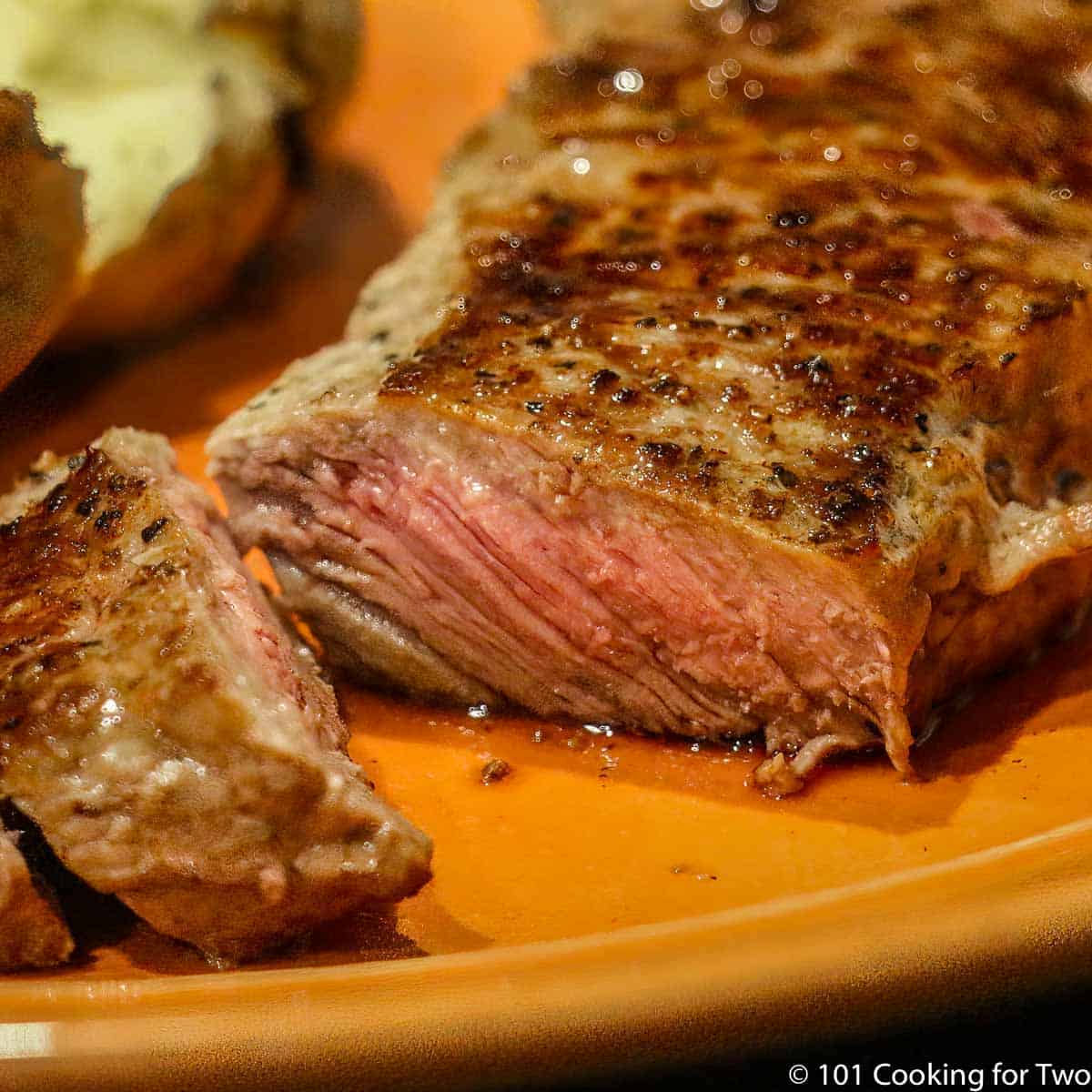
TABLE OF CONTENTS

Featured Comment from Colleen:
"5 stars—I made this for my family tonight. I got 5 STARS from even the pickiest eater."
Cook like the best steakhouses. Searing steak in a cast-iron skillet will give you the wonderful flavor of the Millard reaction. Then, finish the steak in the oven to your desired temperature.
Learn the sear and bake technique with easy step-by-step photo instructions—a foolproof recipe for moist and tender steak every time. For equally great results on the grill, check out How to Grill New York Strip Steak on a Gas Grill.
👨🍳How to Cook a New York Strip Steak—Step-by-Step Photo Instructions
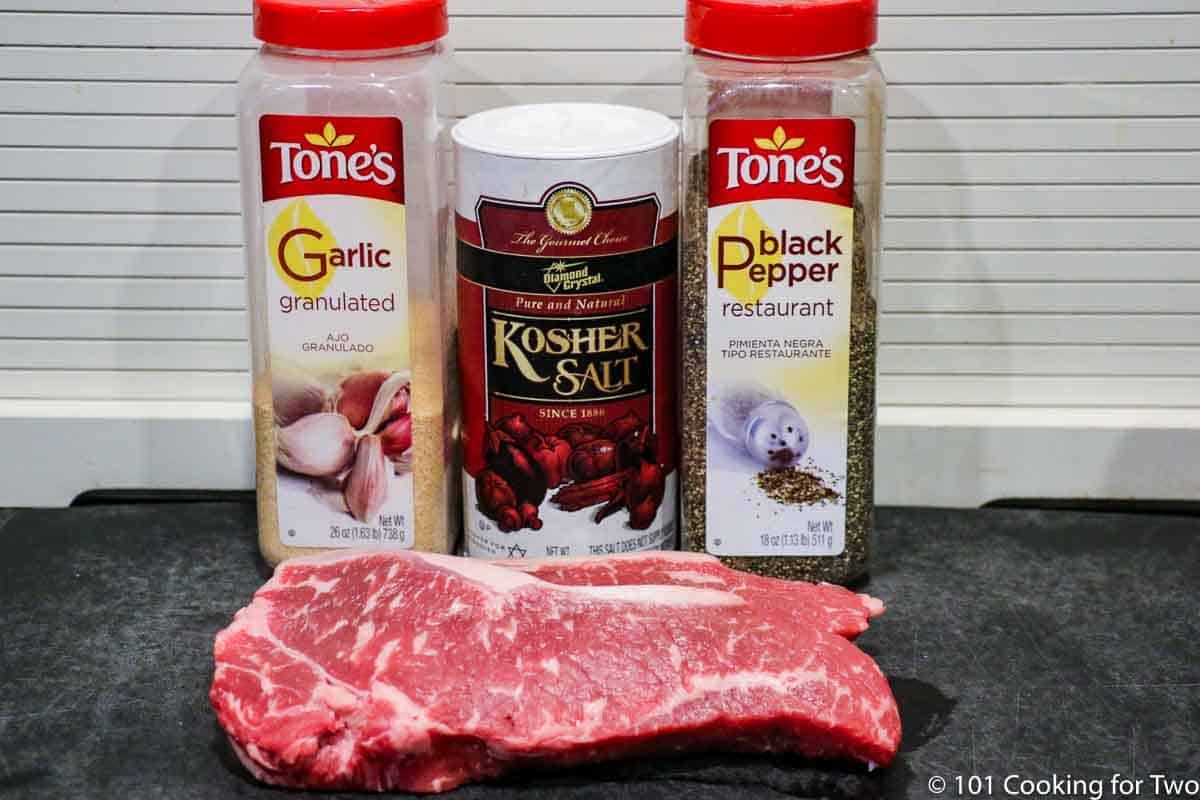
1. Allow the steaks to rest at room temperature for 30-60 minutes.
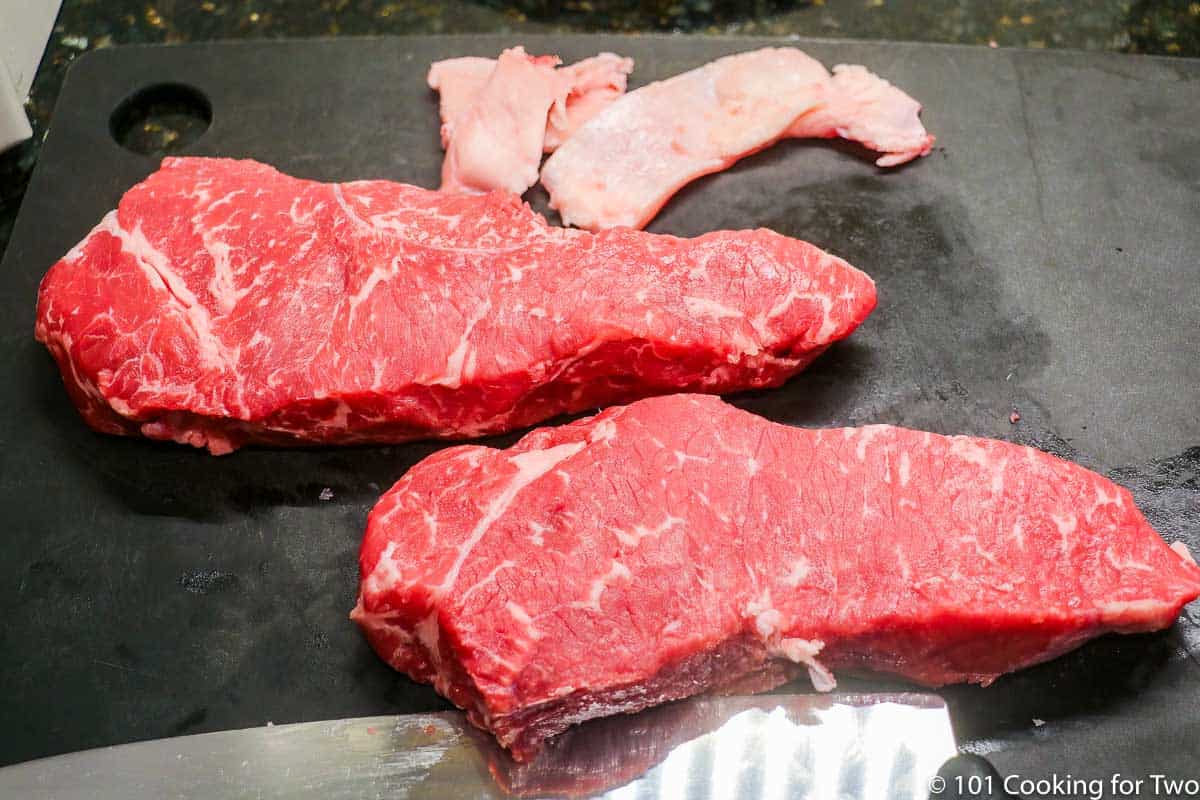
2. Trim any easily trimmable edge fat. Pat dry with paper towels.
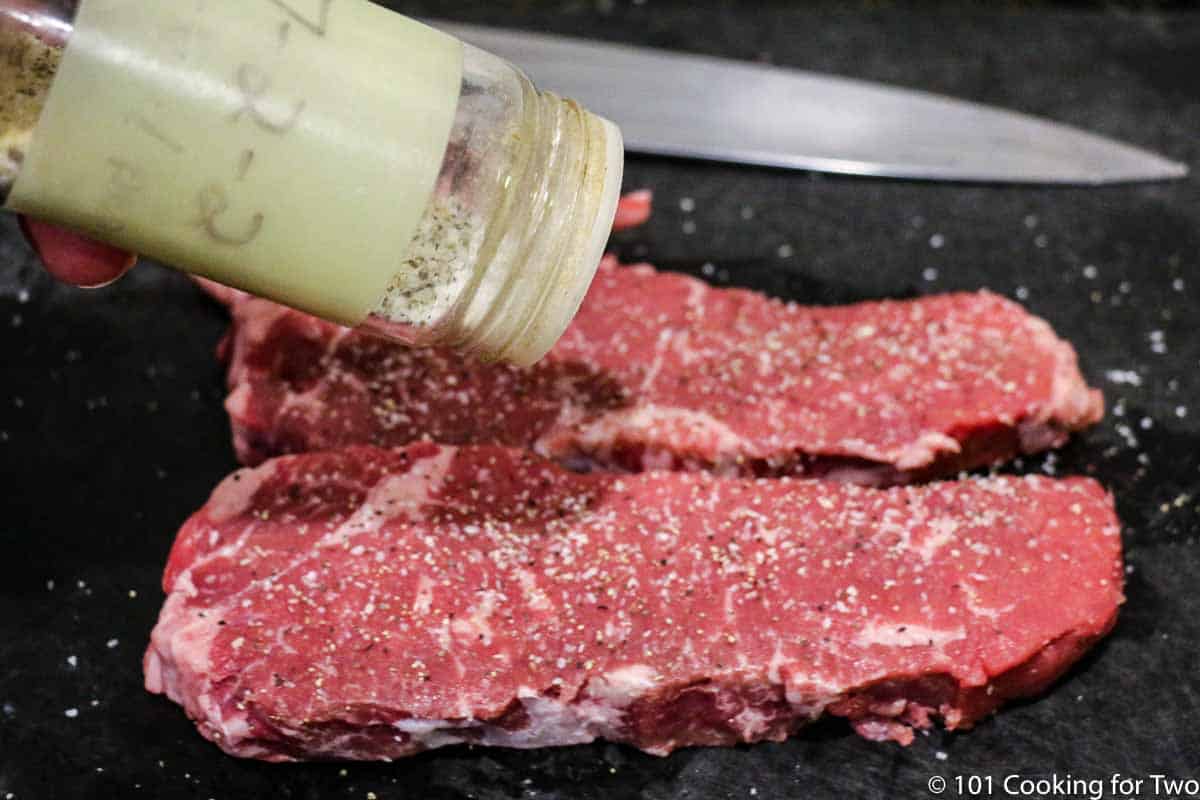
3. Season to your taste.
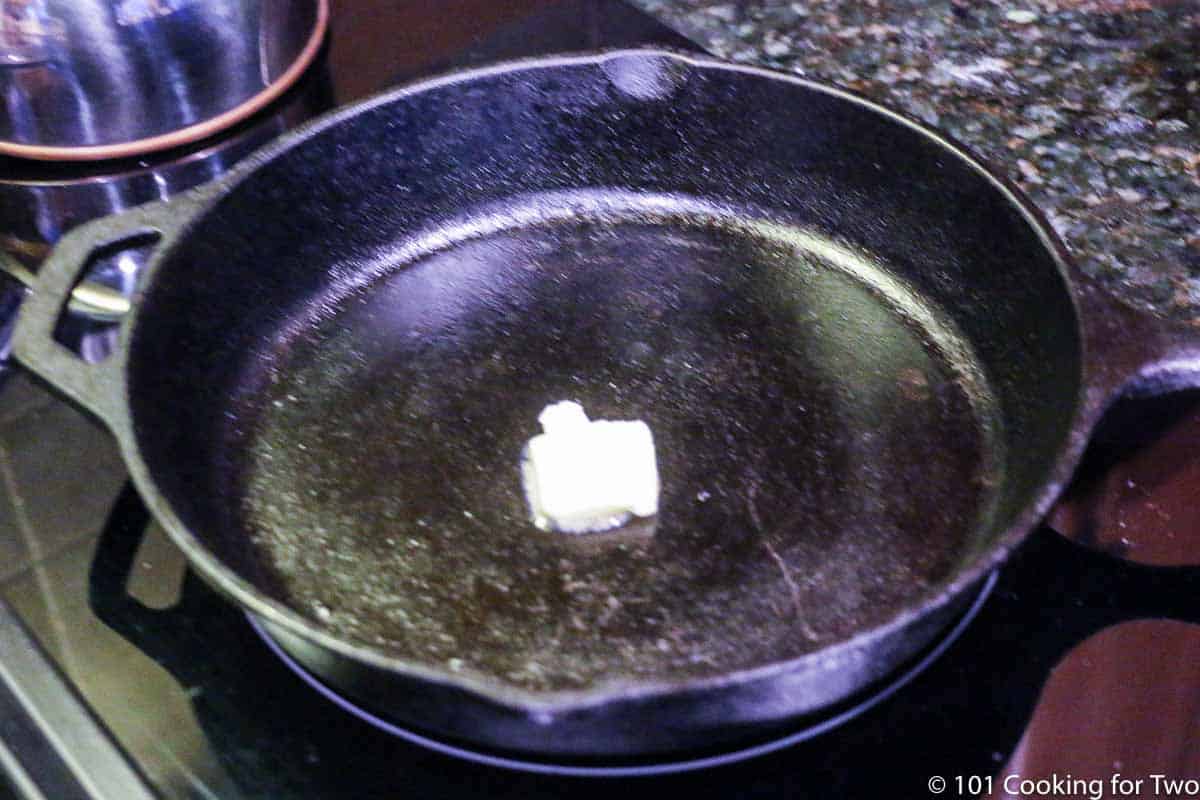
4. Melt butter in a cast-iron or other oven safe pan..
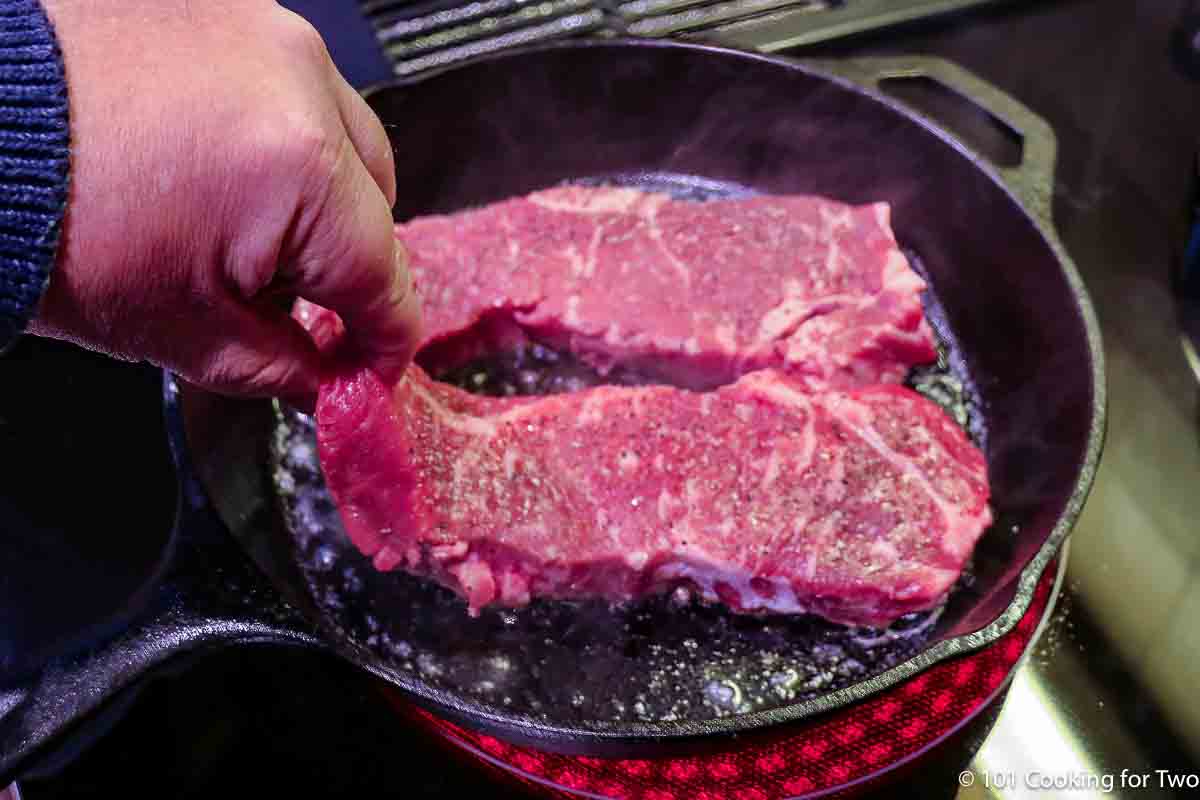
5. When the pan is hot, add the strip steaks.
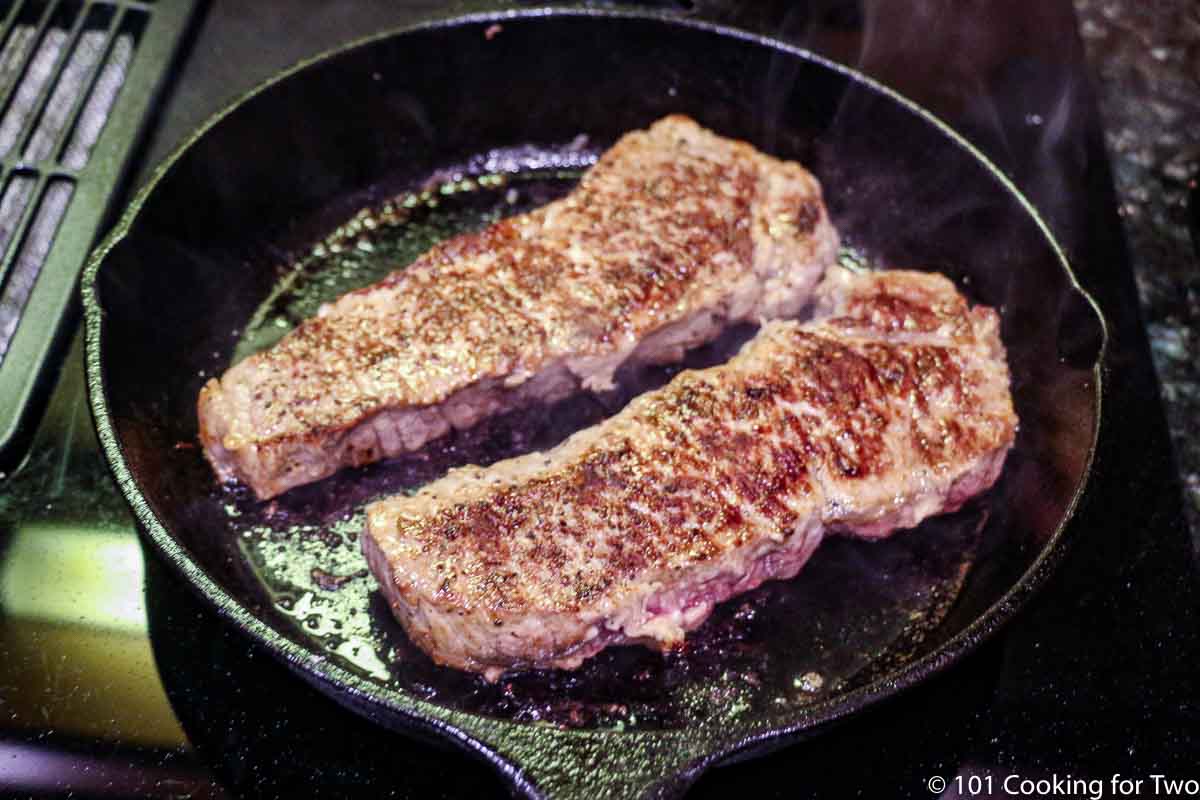
6. Sear both sides of the steaks for about 2 minutes each.
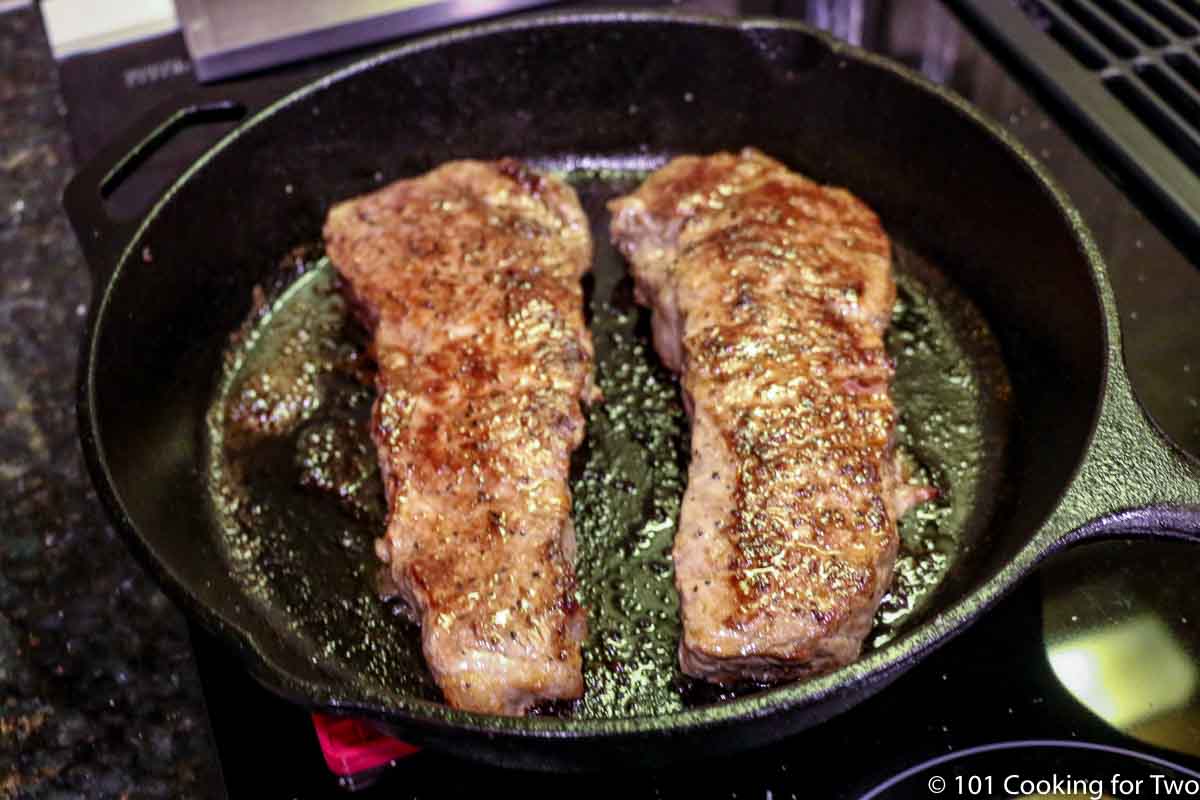
7. Move to a 400° oven. Cook to the final temperature minus a few degrees—about 5 to 7 minutes to reach 130-135° (medium-rare) or 7 to 9 minutes for 140°-145°
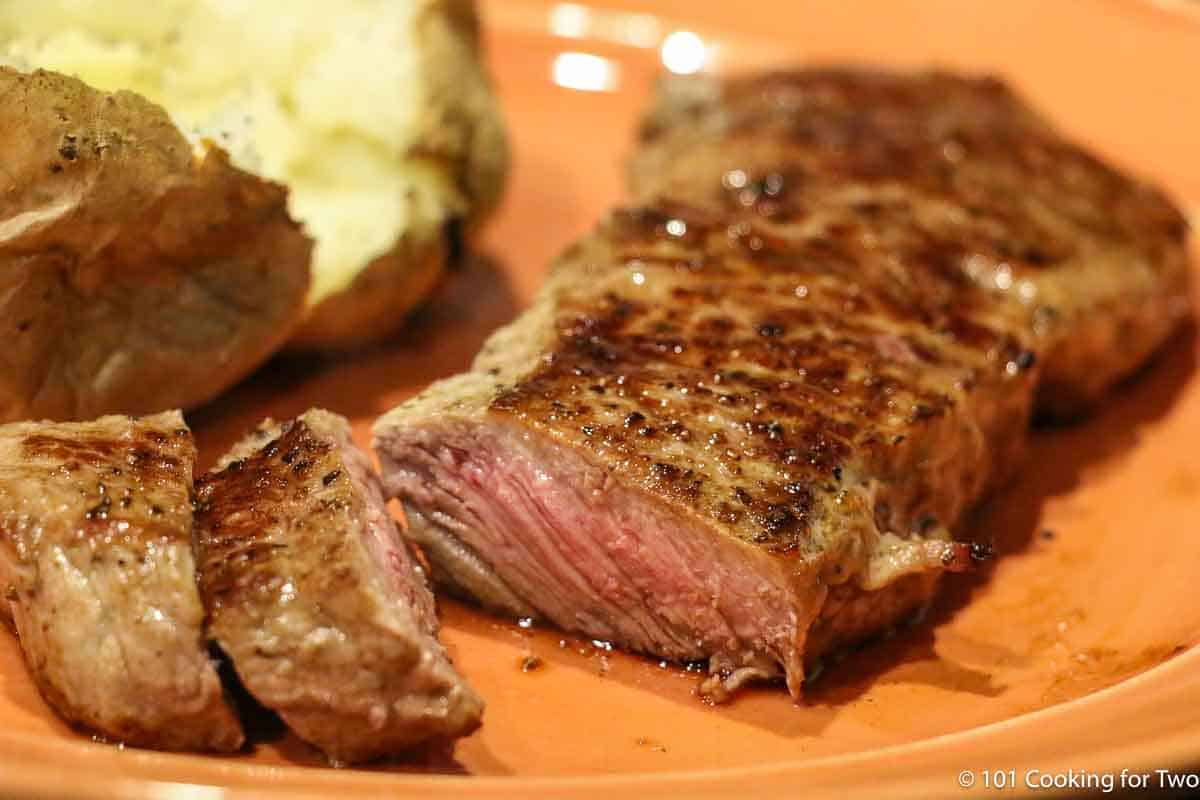
8. Remove from the oven, tent with foil, and allow to rest for a few minutes before serving.
For more details, keep reading. See the Recipe Card below for complete instructions and to print.
⏰How long to cook strip steaks in the oven
Total cooking time for a 1-inch NY strip steak to 140° (medium) is about 11-12 minutes, including a 4-minute sear and 7-8 minutes in a 400° oven when rested to room temperature first. For medium-rare (130°-135°), decrease the oven time to 5-7 minutes.
Approximate oven cooking time for strip steaks
Rare—cold red center(125°-130°)—4-minute sear and 2-4 minutes oven time for about 6-8 minutes total cooking time. It may be almost no time in the oven if you did an intense sear with a rest to room temperature or if your steaks are thinner.
Medium rare—warm red and soft center(130°-135°)—4-minute sear and 5-7 minutes oven time for about 9-11 minutes total cooking time.
Medium—pink and firm (140°-150°)—4-minute sear and 7-9 minutes oven time for about 11-13 minutes total cooking time.
Medium well—minimal pink(150°-155°)—4-minute sear and 9-11 minutes oven time for about 13-15 minutes total cooking time.
Well done—firm and brown(160°+ )—4-minute sear and 12-15 minutes oven time for about 16-19 minutes total cooking time.
The best oven temperature is 400° convection or 425° conventional. You can use 350° or 375°, but you must accommodate the cooking time.
Variables affecting cooking time are the rest's length at room temperature, the thickness of the steak, oven temperature, and the length of the sear. Remember, you can cook your steak more if needed, but you can not uncook a steak.
NEVER COOK BY TIME ALONE; cook to your target internal temperature. Please check the internal temperature a few minutes early. Stop cooking a few degrees before to allow the temperature to rise during the rest before serving.
🧂Seasoning and marinades
Coarse salt and black pepper are all you need. Others like to use commercial mixes like Montreal Seasoning. We like to use our All-Purpose Seasoning Recipe, which adds garlic. Thyme, rosemary, or other herbs may also be used to add different flavors.
A marinade will make your special meal stand out. One of our favorite company meals is marinade New York strip steaks using our easy steak marinade.
✔️Tips to cook strip steaks right every time
Quality matters in the steaks you buy—use Prime or Choice grade.
A 1-inch strip steak will be about 12 ounces, while a 1 ½ inch is over a pound. This method works well between ¾ to 1 ½ inches thick. Over 1 ½ inches thick should be cooked with a reverse searing method.
Bone-in strip steak can be used, but realize it will take a bit longer to cook.
The timing of seasoning is important. Salt will pull fluid out of meat, but it will reabsorb in about an hour. So, any salt-containing seasoning should be applied 1 hour before cooking or just before cooking to get the moistest steaks.
Resting before serving allows the fluid that escapes the cells during cooking to migrate back into the cells and make for a moist and tender steak.
Related steak recipes
For the other way to cook great strip steaks, see Grilled NY Strip Steaks. Or see Grilled T-bone Steaks, Grilled Filet Mignon, or Pan Seared Filet Mignon.
What to serve with strip steak?
We love a potato side dish—baked, twice-baked, or smashed potatoes are great compliments. Check out Roasted Red Potatoes, Crispy Parmesan Baked Potatoes, or Twice Baked Potatoes.
Other vegetables like broccoli, asparagus, or green beans are simple ways to round out your meal. Green Beans with Bacon, Baked Parmesan Asparagus, and Parmesan Roasted Cauliflower are some good choices.
Leftovers
Store leftovers in an airtight container or ziplock bag in the refrigerator for 4 days or frozen for 3-4 months.
I like to use cold leftover strip steak cut up for a salad topping. Or you can reheat it in a microwave, stovetop, oven, or air fryer.
🐄What is a Strip Steak?
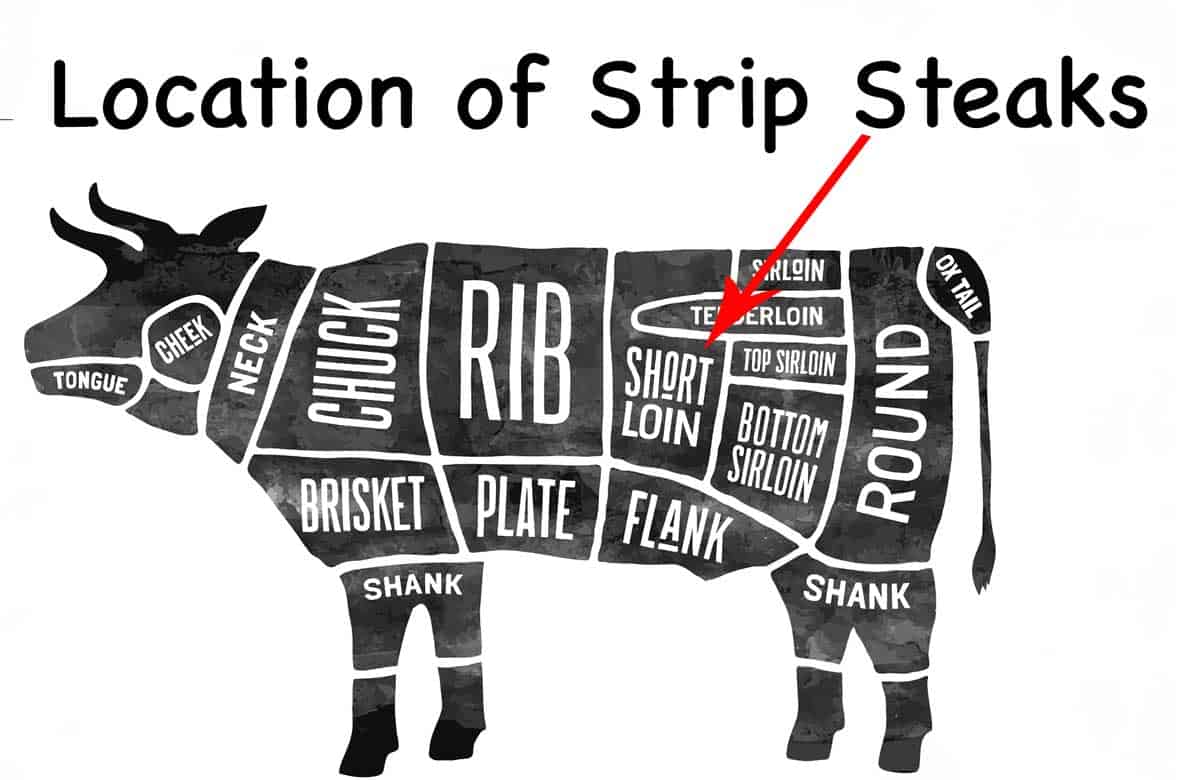
Strip steaks are part of the short loin behind the rib area with the tenderloin. Specifically, strip steaks come from the longissimus muscle, which does little work but has a fair amount of fat that helps make them tender.
Strip streaks are frequently called New York (NY) strip steaks, Kansas City strip steaks, or striploin steaks.
❓FAQs
We will pair the strip steaks with Cabernet Sauvignon, Merlot, or Pinot Noir for an excellent wine complement.
Cast iron is perfect for searing breaking steaks in the oven. It transfers heat evenly across the entire surface without hot spots. It will also hold the heat well and is excellent when going from the stovetop to the oven.
All home cooks should have a cast-iron skillet. They are cheap, easy to maintain, and will last generations. It can also tolerate any heat from a stovetop, oven, or grill you can generate at home.
The pan to sear steaks does not have to be cast iron; any oven-safe pan that can move from stovetop to oven will do. If you don’t have any pan that will work, sear in a stovetop pan and move to a different preheated oven-safe pan to finish.

This recipe is listed in these categories. See them for more similar recipes.
Have you tried this recipe, or have a question? Join the community discussion in the comments.
📖 Recipe
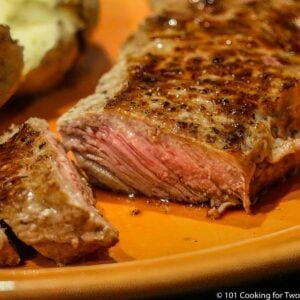
Pan Seared Oven Roasted Strip Steak
Video Slideshow
Ingredients
- 2 New York strip steaks - 1 inch thick
- salt and pepper to taste - or season to taste
Instructions
- Allow the steaks to rest at room temperature for 30-60 minutes if you have time—preheat the oven to 400° convection or 425° conventional oven.
- Trim any easily trimmable edge fat. Pat dry with paper towels. Season to your taste. A good sprinkle of black pepper and Kosher salt is all you need, but I use 7:2:2 (my homemade seasoning).
- Melt 1 tablespoon of butter or use oil in an oven-safe pan (cast-iron preferred) over medium-high heat. Some prefer oil due to butter's lower smoke point, but I have never had a problem with either.
- When the pan is hot, add the strip steaks. Sear both sides of the steaks for about 2 minutes each. Sear until they are close to the final color you want.
- Transfer the pan to the preheated oven. Now comes the variables: the steak thickness, how long you seared it, and the oven's actual temperature. Cook to the final temperature minus a few degrees—the steaks will rise a few degrees during the rest after cooking.
- Bake for about 5 to 7 minutes to reach 130-135° (medium-rare) or 7 to 9 minutes for 140°-145° (medium). Remove from the oven, tent with foil, and allow to rest for a few minutes before serving. COOK TO THE TEMPERATURE, NOT BY TIME ALONE.
Want to save this recipe for later?
Recipe Notes
Pro Tips:
- Allowing steaks to rest at room temperature before cooking helps obtain the final internal temperature. Skip if you must.
- I like to use 400° convection for this recipe, but you can use a different oven temperature and don't have to have convection. Remember, you are cooking to a final temperature and not by time.
- Trim excessive fat.
- Seasoning just before starting to cook or one hour before is best. Use the seasoning of your choice or some coarse salt and pepper. Marinades will also work well.
- You may use butter or oil in the pan. Butter has a lower smoke temperature. I have not had an issue with it, but if you have very hot burners or are worried, use oil.
- After removal from the oven, you will have a few degrees increase in the internal temperature.
- Allow to rest for at least 5 minutes before serving.
- NEVER COOK BY TIME ALONE. Use an instant-read or meat thermometer to check your internal temperature.
Your Own Private Notes
To adjust the recipe size:
You may adjust the number of servings in this recipe card under servings. This does the math for the ingredients for you. BUT it does NOT adjust the text of the instructions. So you need to do that yourself.
Nutrition Estimate
© 101 Cooking for Two, LLC. All content and photographs are copyright protected by us or our vendors. While we appreciate your sharing our recipes, please realize copying, pasting, or duplicating full recipes to any social media, website, or electronic/printed media is strictly prohibited and a violation of our copyrights.
Editor's note: This article was originally published on February 20, 2015. It has been updated with expanded options, refreshed photos, and a table of contents to help with navigation.


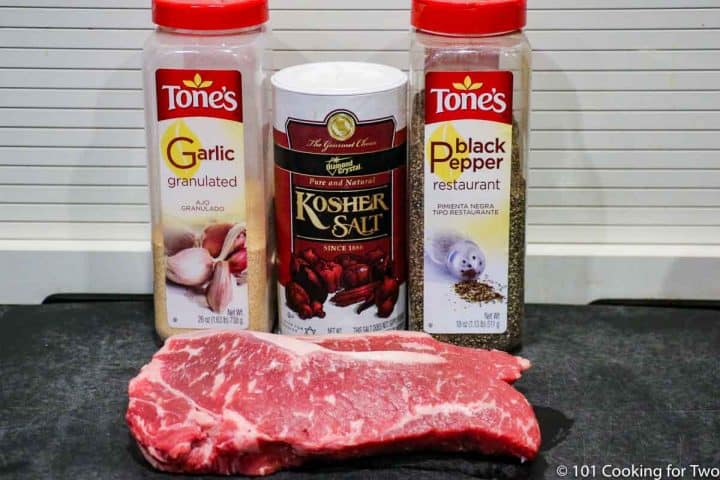
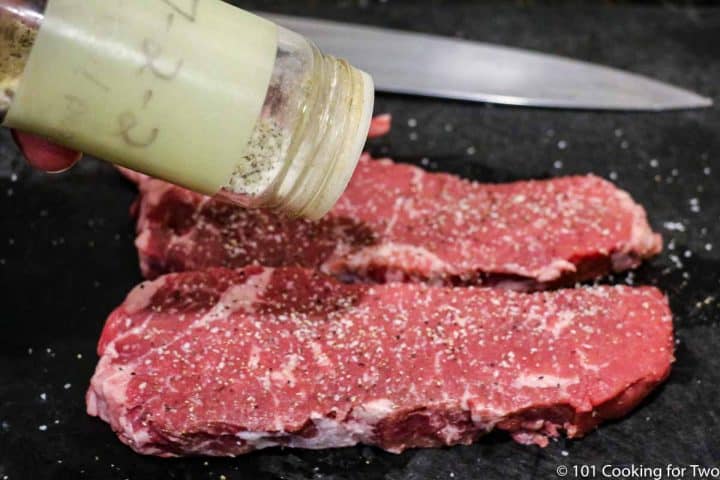
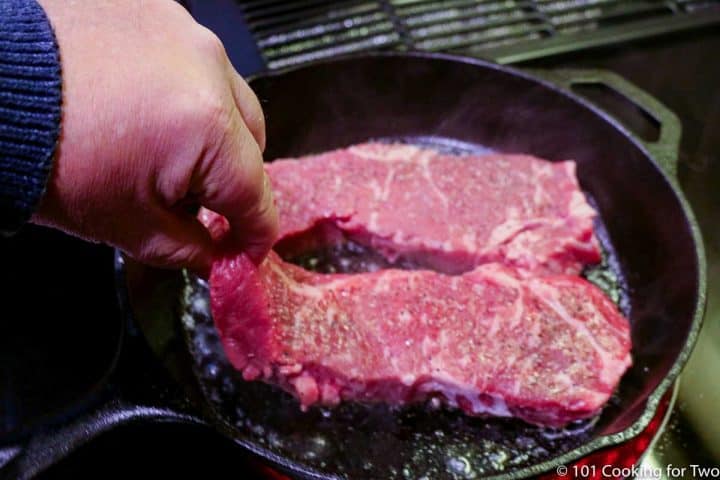
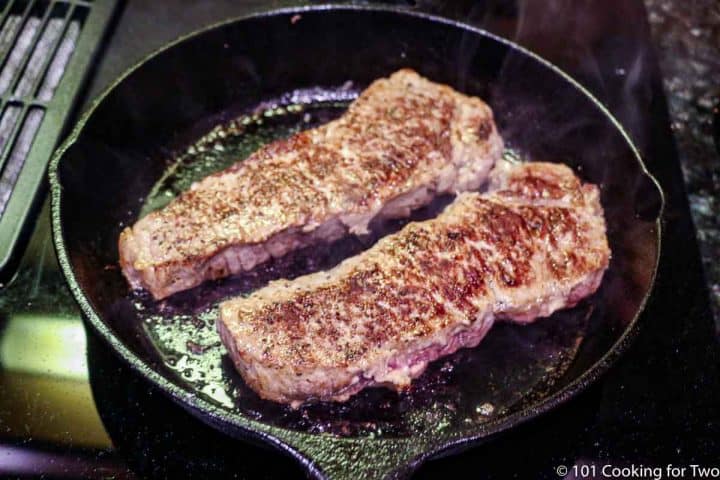
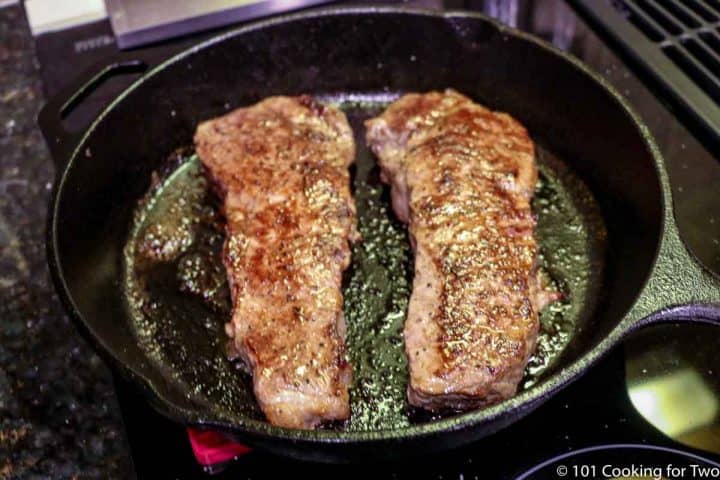
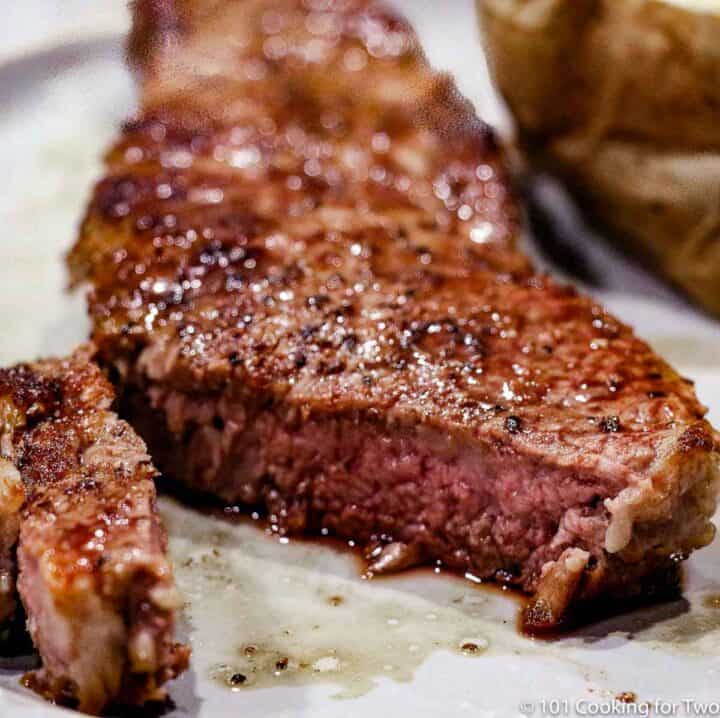
Dana
I just want to say thank you for this easy simple recipe. It has been my go to for years now and it has NEVER failed me. I love simple food that’s delicious. I just wanted to say thank you for all the amazing steaks I’ve mastered through your guidance. ❤️
Dan Mikesell AKA DrDan
Hi Dana,
Welcome to commenting. Always feel free to express yourself.
I'm so glad you are enjoying this and other recipes.
Thanks for the note and rating.
Dan
Julie Haske
Followed these directions for a ribeye. Worked great, tasted yummy! Probably will have it again for Christmas Eve! Thanks again for another great recipe.
Bronzi
I use this recipe constantly. So yummy may make tonight.
Jeff Willis
Great recipe. Thanks. I've also done the reverse method cooking the steaks at low temp around 250 degrees in oven or indirect on grill . When the internal temp gets around 125 degrees sear in a cast iron skillet for 2-3 minutes per side.
Colleen
I made this for my family tonight. I got 5 STARS from even the pickiest eater. I usually do this on the grill, but it is snowing in PA so I decided to give this a try. I used KerryGold butter and Montreal Steak Seasoning but cooked it exactly as suggested. It was AMAZING. Absolutely DELICIOUS! I will ONLY use this recipe from now on when I cook steak inside.
Patty
One of the suggestions for any stove to oven recipe is to put the cast iron pan in the oven while doing the pre-heating. That way the pan is evenly heated before placing it on the stove. Saves the time & energy to heat the pan on the stove before searing the steaks as the pan is already hot and ready.
Elizabeth
OMG, what an excellent suggestion!! Thank you so much!
Gail Vaughan
Tried this recipe after I went to light our grill only to discover we were out of gas. Already had the steaks marinating and out at room temperature. I was skeptical but decided to give it a try. It was wonderful! Great option to grilled.
Kellia
Trying this recipe tonight, but I have 2 different cuts of steak to cook. 2 New York strips, & 2 Porterhouses (all 1" thick). I'm wondering what the time difference will be in the oven for the PHouses, considering the bones..? Do you have advice on doing both at the same time? Can I just take the strips out to rest sooner and let the tbones go longer? How much longer would you guess? (We're aiming for med-rare to med on all).
Also! I don't have an oven safe skillet. Can I transfer to a large baking sheet instead? If so, shall I let it heat up in the oven while doing the stove top portion so it's preheated? Should I foil line it, or use racks above it?
Any advice welcome!!
Thank you in advance!
Dan Mikesell AKA DrDan
Hi Kellia,
Welcome to the blog.
Not too big of a problem other than cooking that much size at one. T-bone/porterhouse steaks are mostly strip steaks. That big side is just a strip steak. The difference between the t-bone and the porterhouse is just the size of the meat on the other side of the bone which is tenderloin (filet)—bigger in the porterhouse.
I tend not to do this pan-searing method with bone-containing cuts since the meat will shrink some and the bone will prevent the area near it from searing. Not a big issue but that is why I usually grill my porterhouse steaks.
So assuming you don't care if a bit of the porterhouse does not sear much (the rest will sear and it all will cook fine), what are the issues you will face? The bone will delay the cooking slightly (not a lot) and the porterhouses probably are bigger overall. Lastly, the filet part of the porterhouse will overcook-it just tends to cook faster but that always happens and it can tolerate it and still be great.
So I would preheat the oven with a large sheet pan, sear the porterhouse first and transfer to the oven, then immediately sear the strip steaks (I assume you don't have a stovetop skillet large enough to do all four at once). Transfer the strips steaks and check the temp on the porterhouses (probably not done yet).
The porterhouse will probably be done first thanks to the headstart, move to a plate and tent with foil while the strips finish.
No rack or foil but you MUST use an instant-read thermometer to pull this off or you will be flying blind and most likely will crash. If you don't have one, they are about $10 at a big box store (Home Depot/Lowes, Walmart may or may not have one).
Good luck.
Dan
Sara
Hello.. how long would I cook in the oven if the steak is 2 inches thick please?
Dan Mikesell AKA DrDan
Hi Sara,
Welcome to the blog.
For extra thick cuts, it is a long discussion. Briefly, thick cuts should be rested to close to room temperature before starting. Seared and then the oven should be at a lower temp about 375° range. Lower because it will take longer to penetrate and you don't want to overcook the outside. Now the variables: exact thickness, the temperature of the meat when starting the sear, how much sear, the oven exact temp, the pan, you are getting the idea. This is why have have a pork chop and an extra thick pork chop recipes.
So no exact answer. Probably in the 15-20 minute range if I had a gun to my head. You MUST have an final internal temperature goal and a good instant read thermometer to monitor or you may have a disaster.
Hope that helped at least a litte.
Dan
John Del
It always comes down to temp. I would pull them at 10 minutes in the oven and then take the temperature with a *quality* instant read thermometer. As they say, you can't uncook a steak. An oven safe digital thermometer like they sell on Amazon can keep track of the temperature on the fly. 145F for medium.
Paul Hassett
Good morning. I was hoping to clarify a somewhat minor point with all of your stove to over recipes. I have used them all and they are phenomenal. My only question is that if I use the prescribed times, I am generally over. I wanted to ask - where is the over are you transferring the skillet to after searing (middle , bottom, etc)?
I have been using the middle rack, and am wondering if this may be the source of the inconsistency. Thank you for your time and sharing your recipes.
- yet another Dr / home chef
Dan Mikesell AKA DrDan
Hi DrPaul,
Welcome to the blog. A great retirement hobby.
Oven racks should always be placed to keep the meat in the middle of the oven unless otherwise specified. So since the pan and meat are thin, in the middle.
Now about the variability, there are multiple possibilities, the temperature of the meat when you start searing, the thickness of the meat, the temperature of the pan, how much you sear, oven temperature, and the conductivity of heat of the pan(s). So as always cook by final internal temperature.
If your stovetop pan is oven safe, I don't transfer the meat to another pan. So I almost always use a $15 cast iron 10-inch skillet for these recipes. But most stovetop skillets are oven safe at reasonable temperatures. If you are not sure about your stovetop pan, a transfer to a known oven safe pan is in order.
We doctors are looking for reproducable results (that science thing). But think if all the variables and it is just "fuzzy logic," so go by endpoint only.
Hope that clarifies or at least doesn't muddy the water.
Dan
Cheryl
DrDan, this recipe was a 10 out of 10. Perfection. I bought the prime NY Strips at Costco. I seared them for 3 minutes on each side in my cast iron skillet with butter, as you suggested, and finished them off in the oven at 425° for 9 minutes. They registered at 145°. We loved them. Thanks for the recipe!!!
Clarice
Delicious! May not ever grill a steak again. This method is simple. No need to stand out at the grill in the middle of winter. Using oil and my fan on med - high : no smoke problem.
Betti J
Tried this method of cooking steaks tonight. Came out perfect. Seared 2 minutes each side in my cast iron pan followed by 4 minutes in 400 degree oven. Used olive oil in skillet for searing. Best part was my smoke alarms did not go off.
Sharon
Great recipe!! Perfectly delicious. I used butter in the pan and there was no smoking even in the oven. Can’t wait to make it again. How to get on your “cooking for two” Email list?
Thank you for the recipe forgot to say it in the beginning
Dan Mikesell AKA DrDan
Hi Sharron,
Welcome to the blog.
Glad you enjoyed the recipe.
You will find email subscription links several places on the page but here is a direct link to my page that has the link at the top and explains what to expect and how to unsubscribe (super easy).
https://www.101cookingfortwo.com/subscribe
Thanks for the note, rating and interest.
Dan
Katherine Kelley
Most excellent! My cast iron skillet is very small so cut the steak in half & turned out perfect, Thank you for all your recipes.